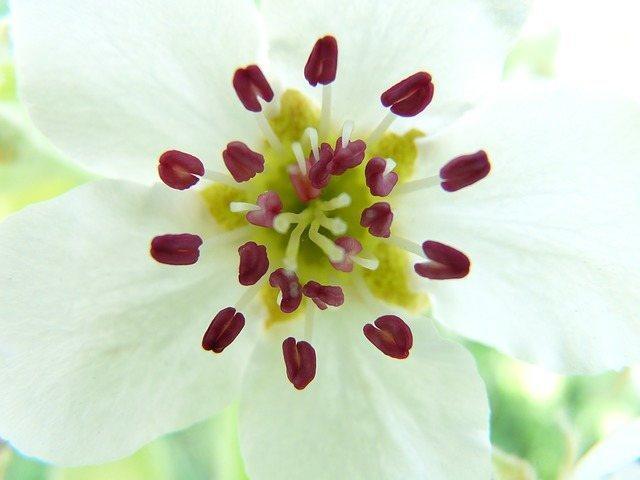
Spalding Pears may very well be one of North Florida's best kept edible landscaping secrets.
CHARACTERISTICS
Spalding is an utterly delicious, soft, eating pear with a complex mellow flavor typical of European pears, yet it has a crunchy, juicy sweetness like an Asian pear.
An established, mature, healthy tree produces loads of medium-sized, round, light green fruit in early September. (photo at right is a typical European pear)
The fruit holds it's texture well and is excellent for fresh eating or even for making preserves & jams. A typical 3 gal specimen will bear fruit in 3-4 years.
At 30ft tall, the Spalding is a medium sized tree in the landscape but it can be heavily pruned to 8-18ft in cultivation. But since pears are generally a lot larger tree than a peach, plum or nectarine, it's a good idea to leave 20-25ft between trees. It's white flowers are about 1" in diameter, smothering the tree in the spring, and filling your yard with perfume & honey bees.
Spalding, or Spaulding as it is sometimes spelled, is amazingly fire blight resistant, too. Fire blight is a bacterial disease common to nearly all pears in the southeastern United States. It thrives in warm, wet springs and is spread during pollination by the bees. Adequate water and nutrition in the fall & winter months, helps strengthen your trees' resistance to disease.
SPALDING PEARS
soft, eating pear with mellow flavors & crunch
POLLINATION
While most pears require a pollinator to produce a full crop or any at all, this European pear is truly self fertile! And because it blooms early with low chill hours, it makes an excellent pollinator for either of our other two favorite soft pears for North Florida: the Hood Pear and the FlordaHome (an IFAS hybrid).
SO WHEN CAN I EAT IT?
Pears have a wide variance in maturity rate: some as low as 90 days, some as long as 200 days. So pears are further divided into 2 generalities: summer pears that ripen in July-August like the 'Bartlett', 'Hood', and 'FlordaHome', and winter pears that are harvested much later in late Autumn and winter, like 'Anjou', 'Bosc', etc. Winter pears don't grow in Florida, in case you're wondering.
The Spalding is in between: it ripens in mid-September!
So while the Spalding is an excellent pollinator for either the Hood (which is like a Southern version of the 'Bartlett') or the FlordaHome (distinctive flavor), it also extends our fruiting season by a full 6-8 weeks!
ORIGIN
Very few nurseries in the South are cultivating the Spalding, hence it is not found commercially in very many places. In Florida, it is easier to source the Hood & the FlordaHome, though it seems to be popular in Louisiana because of its hardy resistance to Fireblight.
All it takes is one dedicated old-timer to keep a species going, and unless he is able to pass his trade to another generation, when he retires, the landscape changes -- literally. Fortunately for us North Floridians, the Spalding is alive and well for now. Available to purchase for local delivery only in Alachua County:
delicious, soft, eating pear: mellow flavor yet crunchy, juicy, and sweet
Texture like a fine European pear, flavor like an Asian pear!
Originally introduced and climatized to the Southern United States, the Spalding also thrives in the Pacific Northwest. Over 90% of the pear crop in the US is grown in the Pacific Northwest and California, largely because of the ability to escape fire blight.
ORIGIN OF PEARS IN GENERAL
Of about 22 species of pears (genus Pyrus) orginating from Asia, Europe, and northern Africa, two major species make up our commercial cultivation: European pears and Asian pears.
European pears are not found in the wild, but are hybrids, many orginating more than 3000 years ago. Intense cultivation began around 1000BC.

pear blossom up close
Later the pear would emerge in ancient Roman cookbooks as a spicey, stewed delicacy. So many English medievil gardens contained pears, it gradually became a part of the natural vegetation of the forests. Asian pears on the other hand are wild varieties that were domesticated in China around the same time -- roughly 1000BC.
THE BOTTOM LINE
The Spalding (or Spaulding) pear is everything a good eating pear should be: juicy, crisp, soft, sweet, and plenty of flavor. And easy to grow.
Grow the Hood if you like a Bartlett with a soft, buttery taste, grow the FlordaHome because it is a differently flavored sweet and soft pollinator for the Hood, and grow the Spalding because it is vigorous, sweet, and both crisp and soft, AND it extends your harvest by up to 2 months!
With all three, you could be harvesting pears from mid July through the end of September. Such a treasure!
SPALDING PEARS
soft, eating pear with mellow flavors & crunch
